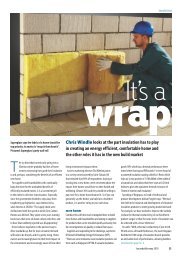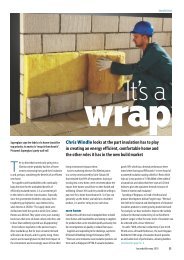Housebuilder October 2018
You also want an ePaper? Increase the reach of your titles
YUMPU automatically turns print PDFs into web optimized ePapers that Google loves.
uild methods<br />
Laying the foundations<br />
H+H has installed some of its products at Pine Lodge, a small scheme in<br />
Chester by Archway Homes.<br />
H+H Celcon Foundation Blocks (325mm x 215mm) in Standard Grade and<br />
3.6N strength were used to construct the foundations for the six new homes.<br />
H+H Celcon Standard Grade Blocks (325mm x 215mm) in 300mm thickness<br />
and 3.6N strength were deployed from DPC level up to roof height in each of<br />
the new homes.<br />
Requiring only a single leaf of blocks, a solid aircrete block can be laid onto<br />
a strip of poured concrete to match the thickness of the wall, H+H explains.<br />
“This method also requires no mortar at the perpendicular joints; instead<br />
they can be butted against each other,” it adds.<br />
Archway Homes’ senior site manager Barry Parkyn says he enjoyed working<br />
with the products. “The H+H Celcon Foundation Blocks were really easy to<br />
use: lightweight and well-packed.”<br />
Continued from page 75<br />
building material, and outstanding thermal<br />
performance,” continues Lane. “Manufacturing timber<br />
frame homes that are more energy and thermally<br />
efficient is becoming easier which is better for the<br />
environment and ultimately, good for home owners’<br />
pockets. We’re currently working on a large MoD<br />
housing development, awarded by Lovell [part of UK<br />
construction and regeneration group, Morgan Sindall<br />
Group] providing timber frame kits for 450 homes<br />
across two sites, handing over 13 plots per week.<br />
Lovell is working to complete 917 homes by May 2020.<br />
Our speed and efficiency on this project is being hailed<br />
as an exemplar to the housebuilding industry.”<br />
timber<br />
Offsite manufacturing and modular housing may<br />
account for a small percentage of the overall housing<br />
market, but “the bulk of housing uses timber and we<br />
are able to provide solutions for roofs using trusses<br />
and floors with both i-beam and metal-web joists,”<br />
says Ed Kirk, operations director at Donaldson Timber<br />
76 housebuilder october <strong>2018</strong><br />
Engineering. “We also have a dedicated glulam<br />
department. Glulam is popular and versatile, being<br />
used for some highly innovative apartment buildings.<br />
Our team has the experience to manage the design and<br />
supply of straightforward or complicated structures.”<br />
prefabrication<br />
Keystone, with its Smartroof offering, is also developing<br />
and manufacturing prefabricated products that help<br />
housebuilders free up skilled trades onsite to speed up<br />
the build programme. “Smartroof is a factory fabricated<br />
room in roof system and can be installed in one day.<br />
It can help housebuilders overcome the issues of skills<br />
shortages by reducing the need for specialist trades<br />
onsite and facilitates faster build programmes as well as<br />
offering improved quality of product and cost savings,”<br />
says Adrian Forbes, group sales director at Keystone<br />
Group. “New offsite options are delivering welcome<br />
advantages for both the designer and the client.<br />
“A good example of a labour intensive task for a<br />
Imperial building<br />
In the handmade bricks camp is Jason Hughes, md of Imperial Bricks.<br />
Demand for handmade bricks has increased “over the past couple of<br />
years”, he says. “The UK needs a mix of different builds to meet the need<br />
for new housing. For niche and high-end developments and new-builds<br />
in conservation areas handmade bricks are increasingly being specified.<br />
Brick-matching is increasingly important, as pressure to build new homes is<br />
leading to development on unusual sites. This means that new houses need<br />
to blend in with their surroundings. Onsite tinting or weathering can also<br />
achieve the right result.”<br />
Some suppliers are unable to meet the demand for handmade bricks –<br />
perhaps reflecting issues in the wider brick industry, Hughes claims. “We’ve<br />
introduced several new bricks including a new Waterstruck range in metric<br />
sizing, which measures up exactly with modern bricks and lintels.”<br />
Handmade bricks are also requested as brick slips, an effective, economical<br />
way of adding an authentic looking finish to block or timber construction,<br />
Hughes says. “We’ve made all of our range available as brick slips.”<br />
“New offsite options<br />
are delivering welcome<br />
advantages for both the<br />
designer and the client”<br />
Adrian Forbes, group sales director,<br />
Keystone Group<br />
skilled joiner on site, requiring multiple trades to<br />
construct, would be [creating] a dormer. Compare<br />
that process to a factory built dormer which benefits<br />
from economies of scale and enhanced quality as it<br />
is managed at every stage of production. The process<br />
to insulate the dormer in a factory environment<br />
for example is likely to result in a far superior finish<br />
without the voids or gaps in insulation which often<br />
occur on site, resulting in cold bridging issues.”<br />
Closing the gap between designed and built<br />
performance should feature heavily within the R&D<br />
team of every building material producer, Forbes<br />
counsels. “Ease of installation combined with quality<br />
detailing is vital as the labour market tightens and<br />
skills shortages mount. Our job is to innovate for<br />
easier installation, reducing the number of tasks to<br />
be completed onsite while at the same time raising<br />
energy performance levels,” he concludes.<br />
Nick Whittle, joint managing director of Target<br />
Continued on page 79 4







